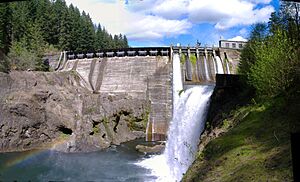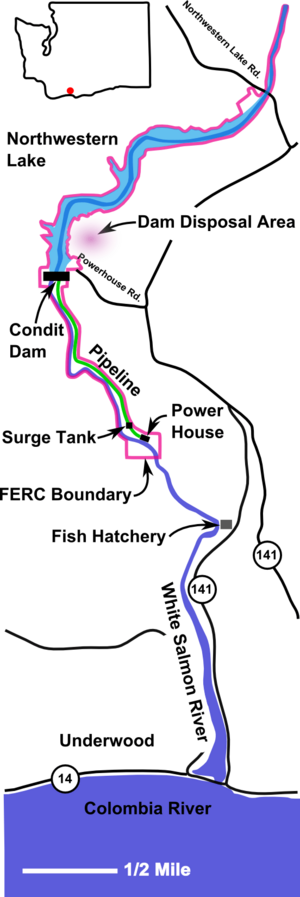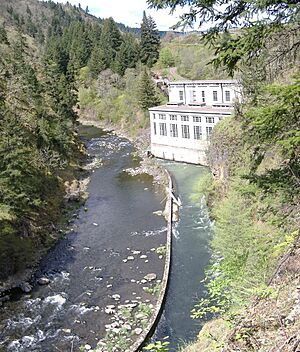Condit Hydroelectric Project facts for kids
The Condit Hydroelectric Project was a large dam built on the White Salmon River in Washington. It was finished in 1913 and helped provide electricity for local businesses and homes. This dam was even listed as an important engineering and architecture landmark.
However, the company that owned it, PacifiCorp, decided to take it down. This was because the costs to protect the environment around the dam became too high. So, on October 26, 2011, the dam was intentionally broken open. At that time, Condit Dam was the biggest dam ever removed in the United States. Later, even larger dams, like the Elwha Dam and Glines Canyon Dam on the Olympic Peninsula, were removed as part of the Elwha Ecosystem Restoration Project.
Contents
What Was the Condit Dam?
The White Salmon River gets its water from glaciers on Mount Adams. It flows into the mighty Columbia River. The Condit Dam was located about 3.3 miles (5.3 km) upstream from where the White Salmon River meets the Columbia.
The area around the dam is known for its beautiful nature. People enjoy activities like whitewater rafting and fishing there. When the dam was built in 1911, it blocked 33 miles (53 km) of habitat for steelhead fish and 14 miles (23 km) for salmon. These fish could no longer swim upstream to lay their eggs.
Building the Dam
The Condit Hydroelectric Project was named after its main engineer, B.C. Condit. The Northwestern Electric Company built it in 1913. During construction, all 242 workers went on strike. They voted for the Industrial Workers of the World to manage their strike.
Once the dam was finished, it mainly sent electricity to the Crown Willamette Paper Company in Camas, Washington. Any extra power was sold to customers in Portland through a power line crossing the Columbia River. In 1947, PacifiCorp bought the project.
How the Dam Worked
The Condit Dam itself was in Klickitat County. It created a lake called Northwestern Lake. Water from the lake flowed through a large wooden pipeline. This pipeline carried the water to a surge tank and an extra spillway. Then, two smaller pipes, called penstocks, sent the water to the powerhouse.
Inside the powerhouse, two special francis turbines and generators made electricity. After the water passed through the turbines, it rejoined the river about a mile (2 km) downstream from the dam.
The Problem with Fish
The dam's original design included fish ladders. These are like staircases for fish, helping them swim around the dam. However, floods destroyed these fish ladders twice, soon after the dam was built. The Washington State Fisheries Department then told Northwestern Electric to support a fish hatchery instead of rebuilding the ladders. This decision stopped salmonid fish from naturally migrating up the river.
In 1996, the government ordered PacifiCorp to change the dam. They had to add new fish ladders to meet environmental rules. PacifiCorp thought these changes would be too expensive. So, they asked to take the dam out instead. The project continued to operate with yearly permits until the Federal Energy Regulatory Commission (FERC) approved its removal. The dam was finally breached (broken open) at noon on October 26, 2011.
At that time, it was the largest dam removed in the U.S. for environmental reasons. Since then, the Elwha Ecosystem Restoration Project has removed the even larger Elwha Dam and Glines Canyon Dams.
How the Plant Operated
River Flow Management
The Condit Dam had to release at least 15 cubic feet per second (0.4 cubic meters per second) of water. This kept the river flowing below the dam. Any extra water was used by the turbines to make electricity. This water then returned to the river about a mile downstream. If there was even more water than the turbines could use, it was released through five tainter gates and two sluice gates. The top of the dam also had a special hinged gate. This gate was designed to break open if the water flow became too strong (over 18,000 cubic feet per second or 510 cubic meters per second). On average, the river flowed at about 1,125 cubic feet per second (32 cubic meters per second).
Making Electricity
The two turbines could use a maximum of 1,400 cubic feet per second (40 cubic meters per second) of water. They worked well with as little as 1,100 cubic feet per second (31 cubic meters per second). When the river flow was in this range, the plant operated as a "run-of-river" project. This means the amount of water flowing in equaled the amount flowing out. Both turbines ran all the time to provide a steady supply of electricity.
If there wasn't quite enough water for both turbines, the plant would switch between running one and both turbines. This was based on how much the reservoir (the lake behind the dam) was drawn down and refilled each day. This cycling was timed to meet peak electricity demands. For example, both turbines would run when many people needed electricity, and the reservoir would get lower. Then, during times of low demand, only one turbine would run, allowing the reservoir to refill. A similar pattern was used if there wasn't enough water for even one turbine to run all the time. A weekly cycle was also added, usually drawing down the reservoir during the week and letting it refill on weekends. This way of operating, called "load factoring," meant the plant acted like a peaking plant. However, this type of operation was reduced in the 1980s and 1990s to make lakefront cabin owners happier.
License to Operate
According to a law from 1920, companies that make hydropower must regularly apply for new licenses from FERC. Condit's license was last checked in 1991, but it wasn't approved. It officially expired in 1993. From 1993 until 2011, PacifiCorp kept the plant running with yearly extensions while waiting for FERC to approve its plan to take the dam down.
In December 2005, PacifiCorp tried to challenge FERC's 1991 decision. This was allowed under a new energy law from 2005. PacifiCorp said this was a backup plan in case their request to remove the dam was denied.
Taking the Dam Down
After PacifiCorp's license was not renewed in 1993, FERC suggested that to get a new license, the dam would need a very advanced fish passage system. This would include fish ladders for fish swimming upstream to spawn. It also required changes to the dam and its operations to ensure 95% of fish swimming downstream would survive. These rules came from the National Marine Fisheries Service. FERC also looked at the option of taking the dam down, estimating it would cost twice as much as adding the fish passage system.
The cost to meet the new rules was estimated at $30 to $50 million. At the same time, these changes would reduce the amount of water available for making power. PacifiCorp decided the project was no longer worth the money and began talking about taking the dam down. In 1999, PacifiCorp announced an agreement and asked FERC for approval. The plan was to start removing the dam in 2006, and PacifiCorp's cost was limited to $17.5 million. In 2005, they asked for an extension to operate until 2008. This would allow them to earn another $3.3 million to help pay for the dam's removal. Many groups were involved in these talks, including government agencies, Native American tribes with interests in the area, and environmental groups.
How the Dam Was Removed
PacifiCorp's plan for removing the dam was different from FERC's ideas. FERC wanted to dig out the sediment (silt and mud) behind the dam or move it around. PacifiCorp's plan was to break the dam in a way that would quickly flush out as much sediment as possible. This would reduce the time that the cloud of sediment would harm the fish and other life downstream.
To break the dam, workers cut a large tunnel (12 feet wide, 18 feet high, and 100 feet long) into its base. The last 15 feet of the tunnel were drilled and then blasted with explosives. Before the blast, a dredge removed woody debris from the dam's inner face. When the dam was breached, the lake behind it was expected to drain within six hours. However, it drained much faster, in only about 30 minutes! The rest of the dam was cut into large blocks and either removed or recycled on-site. When it was demolished, Condit Dam was the largest dam ever removed for environmental reasons and the largest dam ever removed in the United States.
The quick draining of the lake pushed a lot of sediment downstream very fast. This helped create a new river channel above where the dam used to be. The remaining sediment will slowly wash away until plants start to grow there. The cloud of sediment temporarily harmed the aquatic ecosystem (the plants and animals in the water). For example, it negatively affected bull trout for about two years. After that, it became a positive influence because it added nutrients to the ecosystem. Also, a new sandbar was expected to form at the mouth of the White Salmon River. This would affect Native American fishing rights, so PacifiCorp agreed to pay a settlement.




